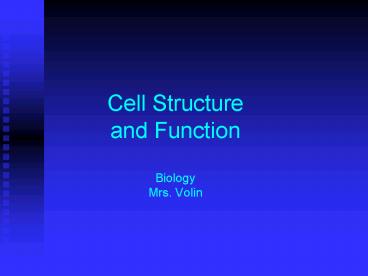Cell Structure and Function Biology Mrs' Volin PowerPoint PPT Presentation
1 / 37
Title: Cell Structure and Function Biology Mrs' Volin
1
Cell Structure and FunctionBiology Mrs. Volin
2
- Anton van Leeuwenhoek, 1600s, Netherlands
- Developed first microscope
- Used simple microscope to
- view living organisms in a
- drop of pond water---animalcule
s - Discovered bacteria
3
- Robert Hooke,
- English physicist,
- 1665
- Observed plant
- tissues under
- light microscope
- Coined the
- term cells
4
- Matthias Schleiden, German botanist, 1838
- all plants are made of cells
- Theodor Schwann, German zoologist, 1839
- all animals are made of cells
5
- Rudolf Virchow, German physician, 1855
- Studied cell reproduction
- All cells come from pre-existing cells
6
Cell Theory
- These 3 ideas form a fundamental concept in
biology, The Cell Theory - 1. All living things are made of
cells. - 2. Cells are the basic units of
structure and function in living things - 3. Cells come from previously
existing cells.
7
Cell Diversity
- Variety of shapes and sizes
8
Typical cell size 5-50 micrometers
diameter
- Smallest bacteria 0.2 micrometers
- Giant amoeba 1000 micrometers
9
(No Transcript)
10
Typical Animal Cell
11
Typical Plant Cell
12
Cell Organization
- The cell includes two basic parts
- Cell Membrane
- - thin flexible barrier around the cell
- Cytoplasm
- - material inside the cell
- membrane, excluding nucleus
13
Two categories of cells
- Prokaryotes
- Do NOT have a nucleus
- Consist of the bacteria
- No other membrane-bound structures
- Eukaryotes
- Nucleus
- Membrane-bound organelles
14
(No Transcript)
15
Cell Membrane
- Made up of lipid
- bilayer
- double-layered sheet
- Regulates what enters and leaves the cell
16
Cell Membrane
17
Nucleus
- Controls cells activities
- Contains cells genetic material (DNA)
18
Endoplasmic reticulum (ER)
- A network of tunnels throughout the cytoplasm
for cell transport
- rough
- smooth
19
Ribosomes
- Where proteins are
- assembled
- Comprised of RNA
- and protein
- May be attached to ER, or freely floating
20
Golgi Apparatus
- Stacks of flattened membranes
- Package molecules for export out of cell
Vesicles carry materials into GA on one side and
out on opposite side
21
Mitochondria
- Powerhouses of the cell produce energy for
the cell - Cellular respiration occurs here
22
Cytoskeleton
- Skeleton of the cell
- Two types of structures
- Microtubules function in cell division
- Microfilaments aid in movement and support
23
Lysosomes
- Break down food molecules to be used by cell
- Break down
- organelles that are
- no longer functional
Question What does the root word lys mean?
Answer lys or to lyse means to break down
24
Centrioles
- In animal cells (not plants)
- Function in cell division
- Bundles of microtubules
25
Cilia and flagella
- Provide locomotion
- Sweeping motion of cilia moves material through
tubes
26
Vacuoles
- Fluid-filled sacs
- Store or carry salts, proteins, carbohydrates,
water, etc. - In plants, central vacuole filled with water
27
Central vacuole
28
Chloroplasts
- Site of photosynthesis
- Found in plants and other organisms that carry
out photosynthesis
29
Structures in Paramecium cell
30
Structures in an onion cell
31
(No Transcript)
32
(No Transcript)
33
- Bacterial Cells
- DNA is circular
- DNA in nucleoid
- Cell wall
- Capsule polysaccharide layer provides
protection
- Pili
34
Theory of Endosymbiosis
35
Theory of Endosymbiosis
- Mitochondria and chloroplasts originated as
prokaryotes that came to live inside eukaryotic
cells - (evidence mitochondria and chloroplasts
have - own DNA)
Dr. Lynn Margulis
36
(No Transcript)
37
(No Transcript)

